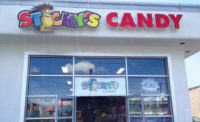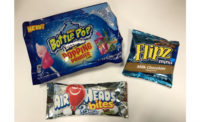Counting Candy
BY RENEE M. COVINO
Sure there are industry pressures, but the confectionery industry numbers tallied up nicely for 2006 — with 2007 already breaking one seasonal record so far.
Despite some
confectionery volatility in the form of supplier consolidation, category
blurring, sugar price inflation, discriminatory taxation, vending
restriction and concerns about marketing and advertising to children
— candy is still dandy. The industry has a lot to stand up and
proudly be counted for — starting with 2006’s $28.9 billion in
total retail confectionery sales and $18.8 billion in total manufacturer
confectionery sales, a 2.8 percent increase over 2005, according to the
National Confectioners Association (NCA) estimates on the 2006 U.S.
Department of Commerce 311D Report, and NCA monthly shipment reports. All
three major sub-segments — chocolate, non-chocolate, and gum —
experienced increases in sales; the gum category saw the biggest sales
gains (+3.6%), but chocolate was close behind (+3.1%).
There’s more positive growth in poundage, too.
Over the past five years, the total pounds of confectionery products sold
at retail per year has increased steadily; in 2006, 7.4 billion pounds of
candy was sold, up from 7.3 billion pounds in 2005, according to the NCA.

In the food, drug and mass channels, candy and gum still ranks third in volume among all food categories, behind only carbonated beverages and milk, but confectionery is a growth category whereas the other two are flat to declining. Right behind candy and gum, salty snacks ranks fourth, another good growth category, according to IRI data for the year ending December 2006.
Pulling apart the sub-segments, gum is being led by
sugar-free gum, which “just absolutely continues to go through the
roof,” according to Jim Corcoran, vice president of trade relations
for NCA. Industry data estimates that gum sans sugar now makes up almost 80
percent of the total gum category; new product introductions are coming
more quickly than at any other time in the category’s history from
leading players in the industry. Consumer trial and acceptance is also at
an industry high for the category.
Chalk it up to chocolate
Chocolate is another powerful force of growth in
confectionery — not only in total chocolate candy, but also in the
wind beneath its wings — the premium chocolate market, which overlaps
the emergence of dark chocolate as a category unto itself. According to
just-released research from research firm Mintel International, the premium
chocolate market is growing at a dramatic rate: Sales through all channels
increased 129 percent from 2001 to 2006 — from $896 million to $2.05
billion. Since 2002, when the market first began to “gain
traction,” as Mintel puts it, it has been growing at a rate of about
14 percent year to year, thanks to the growing consumer interest in dark
chocolate for self-gifting/reward, as well as the positive health news
linking the “darker side” of chocolate to heart health.
Dark chocolate has seen significant growth, increasing
49 percent from 2003 to 2006, or 35 percent in constant 2006 prices, from
$1.26 billion to $1.88 billion, reports Mintel. Not surprisingly, Mintel
discovered that the growth for dark “more or less parallels that of
premium chocolate.” But even dark chocolate products that do not fit
the price/quality/perception/ positioning criteria for premium (in
other words, dark chocolate that is positioned as mass market chocolate)
has also seen an increase, and this can be attributed to the positive
health link attributed to dark chocolate. As one regional grocery retailer
reported earlier this year, the mainstream Hershey’s Special Dark bar
has recently become one of its top sellers at the front end.

But dark/premium is not the only beaming light coming off the American chocolate market. Beyond the sales figures, Mintel’s consumer survey found that premium milk chocolate should not be ignored; the research unwrapped the fact that among respondents who eat premium chocolate, 43 percent prefer dark, but 42 percent still prefer milk.
“It made it clear that there is a big untapped
market for premium milk chocolate,” says Marcia Mogelonsky, senior
research analyst at Mintel. She cautions the industry not to get too
comfortable with the position that the majority of premium chocolate should
be sold as dark chocolate, despite the fact that in 2006, dark premium
chocolate launches were up 83 percent over 2005, while milk premium
chocolate launches were up only 35 percent, according to Mintel data.
“People will pay more for milk if it is
positioned as premium — milk chocolate with sea salt and almonds from
Spain, for example — something like this should be front and center
and merchandised right beside premium dark,” she says.
“Retailers need to make a big deal out of the premium milk as a plan
to action — this is brand new stuff, brand new research.”
Happy Holidays – Really Happy Holidays for Candy
Confectionery is becoming more seasonally savvy,
thanks in part to better/earlier visibility at retail, as well as
maintaining merchandising strength in all of the major, and even some
minor, holidays, too. What is perhaps most special about the 2006 seasonal
candy market is the fact that all four major holidays showed growth.
“It was the first time in more than five years” that this
occurred, according to NCA’s Corcoran.
Just how candy-happy were the holidays? Looking at
sales figures compiled by NCA based on input from IRI, NCA/CMA Monthly
Shipment Reports, and U.S. Department of Commerce, Valentine’s Day
candy sales for 2006 totaled $971 million, showing a growth of 0.1 percent
(but a growth nonetheless, especially compared to 2005’s 4 percent
decline). Easter candy sales for 2006 totaled nearly $1.9 billion,
displaying the greatest holiday growth of 7 percent (and again, quite the
positive change from 2005’s 7.6 percent loss). Halloween candy sales
for 2006 totaled nearly $2.15 billion, growing 2.8 percent (slightly better
than the 2.3 percent growth the holiday had in 2005), and Christmas candy
sales for 2006 rang in at nearly $1.4 billion, showing sales gains of 1
percent (the only major holiday that saw better growth in 2005 with a 2.4
percent increase).
But there’s even better news to report with the
first major candy holiday of 2007, Valentine’s Day. Despite the fact
that there was some pretty snowy weather in various parts of the country
the day before and the actual day of the holiday, Valentine candy sales
were “just incredible,” maintains
Corcoran. At press time, calculations were still being tabulated, but
“I’m probably going to come out with a growth number that is
going to be in the range of 6-8 percent total,” he says. So this past
Valentine’s Day will be up there with one of the greatest growth
holidays in recent times. For the past five years, only Easter of last year
is in line with its growth.
Other single categories that are doing well according
to industry data — licorice continues to outperform the overall
confectionery category in dollar sales growth, as does chewy candy, which
includes gummies and the overall non-chocolate chewy candy category.

Sales are reportedly flat in non-chocolate novelty/kids’ candy, but it’s certainly holding its own. As is typical of several confectionery categories these days, novelty candy overlaps with others, such as seasonal candy, so there needs to be a better understanding/clearer definition as to what constitutes novelty candy for a true reading. Besides, “Whether it’s the next movie or the next item, we’ll see tremendous growth again there,” according to Corcoran. “Growth is always just an idea away in that category.”
Of-the-Wall Candy Watch
The confectionery numbers
for 2006 are all boxed up and neatly presented, but where does that leave
candy being sold today? Perhaps some of the best merchandising ideas for
present and future category growth are slightly off the wall and out of the
box. Here’s a look at some of the directions we see things heading,
with input from a few nontraditional sources as well as some established
industry stalwarts.
More organized chaos. As
trends in dark/premium chocolate continue to rise, with new SKUs becoming
quite proliferated and pervasive, “retailers are going to need help
with the organization of it all,” believes Ginny Valkenburgh, senior
vice president at Cannondale Associates. But that definitely doesn’t
mean sticking to some cookie-cutter retail-channel formula that tidies the
department up in a neat and planogrammed bow.
“Every retailer should be different in terms of
how they’ll handle it; they’ll need to pay more attention to
how they can meet the needs of their particular shoppers,”
Valkenburgh explains. That is probably going to mean incorporating more,
not fewer, candy items in forward-thinking impulse displays, such as at
self-checkout locations, prepared meal solution stations, gift outposts and
unique cross-merchandising opportunities. The expectation is that not only
will displays get more complex, but so will retailers and their supposed
“channels.”
“We keep thinking that the blurring has gotten
as blurred as it could, but mass merchandisers continue to add gas stations
even though the price of gas keeps going up, and dollar stores are still
adding more coolers, so I’m not sure we’re nearing the end of
that yet at all,” says Valkenburgh. “Retailers from all walks
are still looking at more and more ways to differentiate themselves, and
the way they’re getting at that is to try and understand what their
particular shoppers want.”
Her belief is that adding to the mix will remain in
vogue; it’s just that the mix will be better managed.
On-the-go gourmet. First,
there were juice boxes and string cheese; then came bottled water and
granola bars; now there is a fine future for wine boxes and gourmet
chocolate take-alongs, according to April Masini, author and advice
columnist on relationships and consumer lifestyle trends.
“People I counsel are dating more than ever, with the divorce
rate sky high, and the marriage rate for second, third, and fourth
marriages way up,” she explains, noting that for some, lifestyles
have become more fluid. “There is a need for festive, gourmet foods
that can be popped in a purse, a backpack, the back of an SUV, or just kept
in storage at the office or kitchen pantry.”
Cross-merchandising ‘mixers.’ Putting potato chips out in a retail display during
football season, “there’s not a lot of originality in
that,” observes Dan Santy, president of Phoenix-based Santy
Advertising. Instead, he sees the future of cross-merchandising in the
candy and snack arena as giving customers ideas on how to use combinations
of products — for example, putting out recipes and samples of a candy
that might go well with a salty snack — in the same vein as the taste
sensation of a chocolate-covered pretzel. “Consumers are literally
hungry for ideas,” he says. “We’re creatures of habit,
but when we’re presented with a truly good, unique idea, such as a
great sweet/savory flavor combination, we’re interested, and we want
to try it.” Of course, part of that success depends on the
retailer’s ability to partner well with manufacturers and then
together, capture end consumers in an effective way.
“I see tastings and samplings going on all the
time at various retailers, but they’re intrusive,” warns Santy.
He believes their future success will depend on even more engaging and more
relevant customer interaction — true originality and taking chances
will have to come into play.
St. Patrick’s Day is now a candy holiday, too. If See’s Candies can promote it, so will other
confectioners, too, eventually. This year the San Francisco-based retailer
and direct marketer began using its e-mail platform to increase sales
during a holiday less associated with a sweet tooth, promoting its popular
St. Patrick’s Day “potato candy” during March. The St.
Patrick’s Day potato candy is made of white chocolate and rolled in
cinnamon and cocoa powder, with pine nuts added to represent the eyes of
the potato. Candies from other manufacturers are expected to crop up with
greenish hues. Or at the very least, retailers could put an assortment of
green and white confections together in a self-made display. Truly savvy
players could also get the candy rolling on other non-traditional
sweet-treat holidays such as Fourth of July or even Columbus Day, not to
mention Mother’s Day, where there’s some definite potential.
Candy sampling where it hasn’t happened before. Speaking of sampling, ideally, the trend will not be left to
gourmet food retailers and wholesale clubs. Sampling candy at a chain
drugstore? “Why not?” asks Phil Lempert, the food marketing
expert known as the Supermarket Guru. “If we want customers to enjoy
confections, especially in light of the premium trends, we need to let them
feel good about tasting them, make people celebrate with them in our
stores. It’s not good to leave them on the bottom shelf.” He
envisions the most forward-thinking, higher volume stores acting almost as
specialty candy stores — celebrating candy by putting it out in plain
sight, featuring the candy smells and offering lots of samples.
Really alternative channels will sweeten the mix. Any place where consumers stand in line or pay for a
service will become a potential candy store of the near future.
Single-piece wrapped candies have already been spotted for sale out of
“fishbowl-type” containers at contract post offices, hair
salons and even tattoo parlors. It’s only a matter of time before
consumers will come to expect more choice from more players.
You’re so fresh.
Candy with freshness dates is on consumer wish lists, according to a recent
online study conducted for the National Confectioners Association by
Lempert’s organization. “The No. 1 thing we heard from
consumers loud and clear is that they want more freshness from the industry
than they’re getting now,” says Lempert. “That includes
everything from expiration dates to more locally-made products.”



